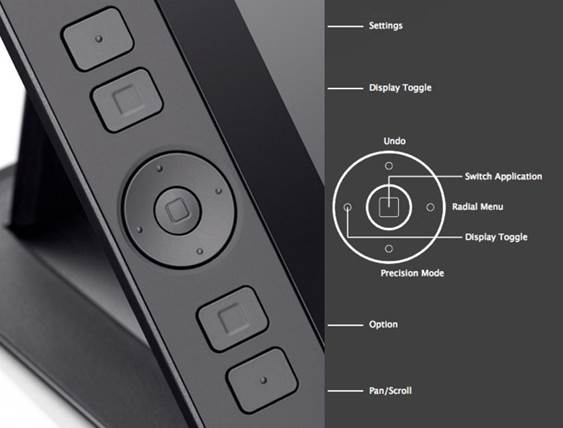In general, the performance is true to what
we can expect from a Wacom screen (and definitely a welcome replacement for the
Cintiq 12WX), but the missing bells and whistles give us pause.
Our curiosity was stimulated immediately when
Wacom revealed a tablet-sized device a few months ago. However, the next reveal
from the company specializes in pen-enabled device was actually the Cintiq 13HD
- a product similar to the outfit's existing displays. We guess we will have to
continue to wait patiently for that truly mobile input device. However, this
time, the 13-inch pen display sports that tablet form factor, but still is a special
accessory for artists, designers and photographers. While the device still
offers the capable, user-configurable ExpressKeys and mighty Cintiq pen, are
the lack of touch gestures and the need to remain wired to your desktop or
laptop deal breakers? Keep on reading to see what we discovered.

Wacom
Cintiq 13HD
Hardware
At first glance with the screen off, the
Cintiq 13HD can be confused with the medium Intuos5 touch. However, take a
closer look; you will see that it provides room to view its semi-gloss,
pen-enabled surface. Wacom's latest device is decorated in an all-black
coating, while a slightly smaller set of ExpressKeys, surrounding a single
Rocker Ring and a centered home button, lines the bezel to one side of the
display panel. Again, these controls have a soft outer layer, providing
comfortable place to rest your weary fingers during an intense work session.
Raised bumps on a few of those toggles allow you
to determine the direction without looking at the numbers. A
power button, USB 2.0 port, 3-in-1 cable jack and LED status indicator are
located on the other side, as opposed to these user-configurable buttons.

A
slightly smaller set of ExpressKeys, surrounding a single Rocker Ring and a
centered home button, lines the bezel to one side of the display panel.
Around the back, there's a panel of the
same soft-touch material embossed with the Wacom logo that covers a portion of
display and two squares of it on the opposite end. A pair of slots for the
included stand can also be found at the rear. In terms of size, the Cintiq 13HD
measures 14.75x9.75 inch (375 x 248mm) and about a half inch thick in general,
but the screen or "active" area measures 11.75x6.75 inch (299x171mm)
or 13.3 inches diagonally. These dimensions make this pen display slightly
portlier than the Toshiba's Excite 13, if you are looking for size comparison
with a full-size 13-inch tablet. It is also heavier, about 2.65 pounds.
Included in the box - just like with the
larger Cintiq offerings, although much less strong this time - is the stand.
The black and silver accessory offers notches for those built-in slots on the
back of the 13HD; with a little more of that soft-touch material to minimize
scratches and to ensure the thing doesn't slip off the desk. The stand has
separate inserts for 22-, 35- and 50-degree viewing angles and the screen will
remain fixed in a completely flat orientation. Adjusting the angle here is
slightly harder than we saw with the lever pushes on the giant 24HD touch
model. Of course, this is not necessary and a stand-less, in-lap work session
is also an option.

The
stand has separate inserts for 22-, 35- and 50-degree viewing angles
Remember that 3-in-1 port? Well, as you may
have to wait, there's a dedicated cable for that guy. At one end, there's a
single connector that resembles Apple's 30-pin option for the 13HD and on the
other, the cable split into 3 separate connections for USB and HDMI on your selected
computer, and AC adapter. If Mini DisplayPort or Thunderbolt jack is your
chosen weapon, you will need to purchase a $35 adapter (we bought Belkin
accessories at the local Apple store), just like we did for the Cintiq 24HD
touch.

There's
a dedicated cable for that 3-in-1 port.
Display
The major attractiveness on the Cintiq 13HD
is the display. The display measures 13.3 inches (338mm) with 1920x1080
resolutions for full HD viewing with more than 165ppi. Using 75% of the Adobe
RGB color gamut, the panel sorts 16.7 million colors and offers 250 cd/m2 of
brightness. "Semi-gloss" probably best describes the surface because
it only provides enough brightness without bring reflections from external
light. The viewing angle is also quite excellent and we didn't see much depth
between the outer surface and the pixel below that we have observed on the 24HD
touch screen. Close-up work sessions didn't reveal visible pixels like they did
on its massive brother - a welcome improvement. Overall, we liked the screen
quality here than the larger pen peripheral, as the sharpness greatly improves
detailed design work and tedious photo editing.
Cintiq Pen

There's
one box to keep the pen in the upright position which also contains 10 spare
nibs, too.
While the highly capable Cintiq pen does
get a bit of an exterior makeover this time around, internal things mostly remain
the same. The 2048 levels of pressure sensitivity (on the pen tip and eraser)
and soft-touch grip that we liked on the Intuos 5 touch and the Cintiq 24HD
touch are also present here. There’s still one box to keep the pen in the
upright position which also contains 10 spare nibs, too. However, the pen
itself now sports a dapper two-tone, silver-and-black scheme with a dash of
chrome around its built-in buttons. It lines in its own separate case alongside
those extra pen tips and color rings for keeping one pen easily identifiable
from that of a fellow cubicle dweller.